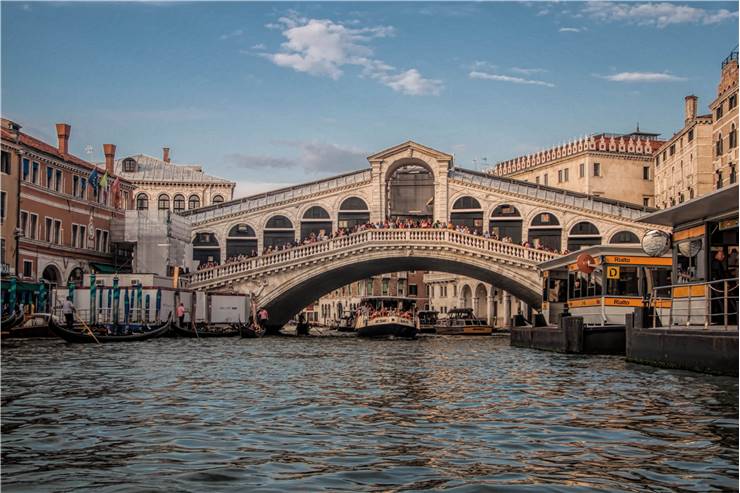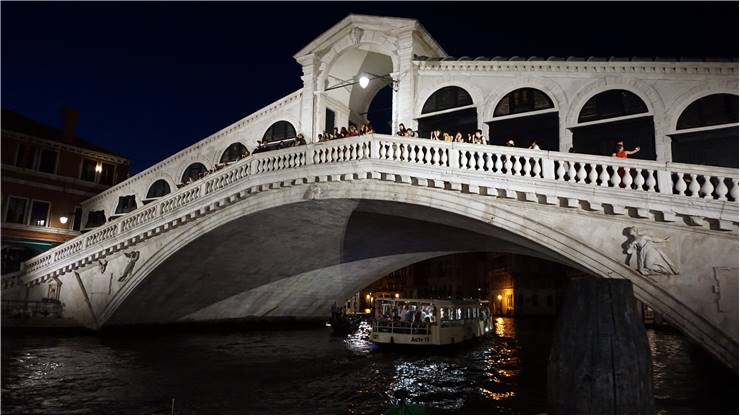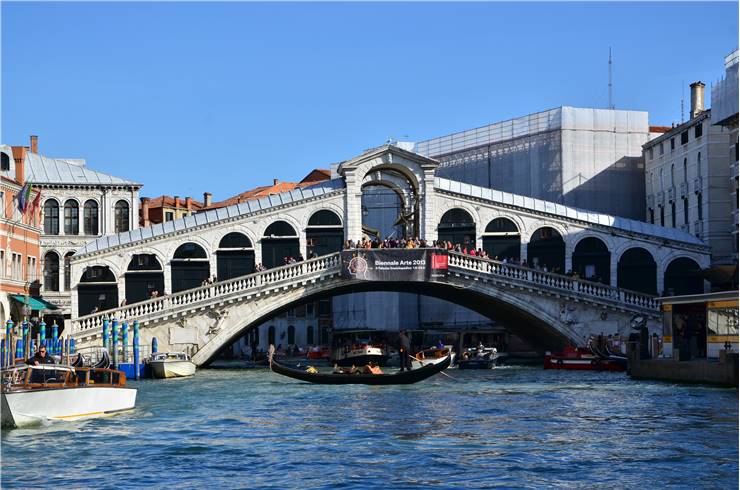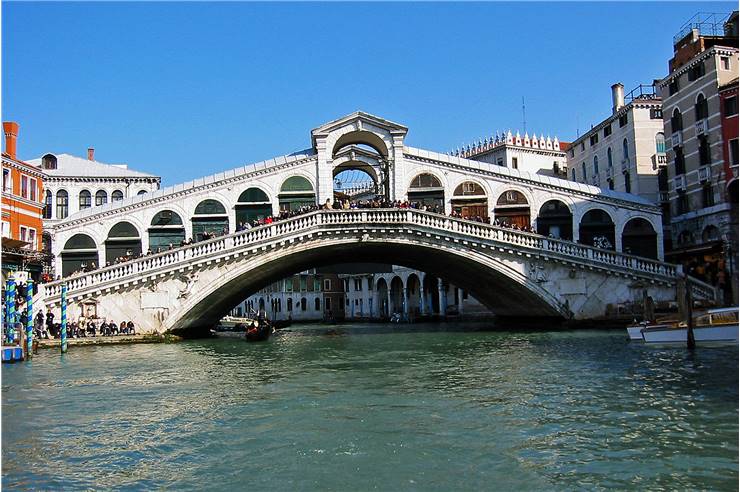Rialto Bridge - History and Construction
The Rialto Bridge is one of the most famous bridges in the Italian city of Venice, spanning the Grand Canal at its shortest part and connecting city districts of San Marco and San Polo. Built in the late 16th century on the location that housed older pontoon bridges, its eye-catching design, and notable location made it one of the most celebrated bridges in all of the Renaissance Italy. While originally it was called “Nicolò Barattieri,” this bridge soon became the pride of all the Venice and became known as “Ponte di Rialto” or “Ponte de Rialto.”
This bridge was built between 1588 and 1591 with a task of becoming a central crossing point in the increasingly congested part of the city of Venice, and especially its nearby markets and trading posts. With the wooden pontoon bridges demanding too many resources to be constantly repaired and maintained, Venice officials searched far and wide for best bridge builders, designers, and artists who could produce an ageless bridge that will elevate the visual appeal of the city. After long consideration, architect Antonio da Ponte was chosen to create 31.8 meters (104.3 feet) long Rialto Bridge whose arch elevates 6.4 meters above the Grand Canal.
Predecessors
The first permanent dry crossing of the Grand Canal in Venice was achieved by Nicolò Barattieri who oversaw the construction of the wooden pontoon bridge called “Ponte della Moneta” in 1181. This structure boosted the importance of that part of the city, enabling the formation of larger markets and gathering of trade both near and on the bridge itself. As with many other city bridges in medieval Europe, merchants saw the appeal of the permanent water crossing as the perfect place for establishing their stores. On some larger bridges, the shops were placed directly on the decking (or immediately on the side of them, supported by wooden beams above the water), or near bridge entrances.
As the Rialto market became larger and more developed, foot traffic on the east side of the city increased so much that the pontoon bridge became congested with travel not only during peak hours of trading but often during the entire day. Additionally, water traffic across Grand Canal was greatly affected by the pontoon bridge, which prevented ships of all sizes from moving freely across the central waterway of the entire city of Venice.
The first solution for those problems was attempted to be made in 1255 with the construction of the first permanent wooden bridge across the Grand Canal. To enable boats to move across the canal easily, the bridge featured two inclined ramps that met at a movable central section. This section could be raised to allow passage of even tall ships.
The wooden bridge was renamed into Rialto Bridge during the 14th century, but in the 15th century, it becomes part of the market with the installation of shops directly on the bridge structure. Shops were arrayed in two rows along the sides of the bridge, with central decking being left for on-foot passage.
Even though the city officials collected taxes for funding and maintain the bridge, the wooden Rialto Bridge did not manage to survive undamaged between the time it was constructed, and the time it was replaced with a permanent stone bridge. The bridge was partially burned during 1310 revolt led by Bajamonte Tiepolo, it collapsed into the water during the 1444 wedding ceremony of Marchessa di Ferrara (plunging into the water all the spectators), and it fully collapsed in 1524, decades after the start of the movement that demanded complete replacement of the wooden bridge.
Construction of Rialto Bridge
In 1504 first ideas started to be voiced about replacing the Venetian wooden bridge near Rialto market with a permanent stone structure that would provide on-foot passage across almost 50-meter-wide Grand Canal, have enough decking to house one row of shops, and provide enough space below for passage of ships. After decades of deliberations, Venice officials finally divided to fund development of fully stone bridge. For this purpose, they contacted all the leading bridge constructors and structure decorators of their time, including architects such as Jacopo Sansovino, Palladio, Vignola, and even the famous Michelangelo. Their choice eventually fell on the Antonio da Ponte who designed a very simple and elegant bridge that was built over the span of four years between 1588 and 1591.
The design of the bridge featured an homage to the original wooden bridge, utilizing similarly inclined ramps on both shores that led to the central portico passageway. The bridge effortlessly housed rows of shops which are still there to this day, and three passageways – two one the sides of the bridge and a central walkway that is surrounded by two rows of shops.
Architect Antonio da Ponte took great care to integrate Rialto Bridge into surrounding city environment. To do that he elected to use Pietra d’Istra (calcareous rock of bright white color) as the main building material which very effectively gave a distinctive look to the bridge – a white stone that is clashing with darkly painted wooden shops. The decking was paved with grey stones that were paler near the edges of steps, which was an intentional choice that helped bridge users to spot the position of the steps more easily. The main deck of the bridge is inclined at a significant angle (15°), which prevents pedestrians to see another side of the bridge from each shore. This approach to bridge-building is not permitted in modern times.
In addition to the strongly angled decking and rows of shops that make the top part of the ship quite distinctive, one of the defining visual features of the Rialto Bridge is its low arch that spans the Grand Canal with the width of 28.8m and height of 6.4m.
During the time of the construction, the bridge received negative comments from some contemporary voices, most notably competing architect Vincenzo Scamozzi who declared that the bridge would not last for long because it was not made in the style of the traditional Roman design with multiple and semi-circular arches.
Modern architects praise the construction effort that original architect Antonio da Ponte invested into the Rialto Bridge, especially its complex superstructure, simple overall design with one arch, and the visual adornments that are still as magnificent looking as they were in late 16th century. After centuries, the bridge remains in excellent health, with only minor color discoloration due to water damage and some staining on the underside of the arch.
Rialto Bridge as Tourist Attraction
The famous fish market of Venice, located at the San Polo district has stood there for 700 years, and the most popular part of it, a shining white Rialto Bridge, weathered all of this time together with it managing to remain preserved in almost pristine condition. As one of the main landmarks in the city that is crowded with historic buildings and locations, almost every walking tour of Venice will inevitably bring you to the steps of this ancient bridge. Nearby around the Rialto Bridge are located some of the most celebrated locations of the “Floating City” of Italy – Bridge of Sighs, Doge’s Palace and St. Mark's Basilica.
Since it is actively used as the shop market, the access to the bridge is open to the public all year long. The tourists can visit it on their own, or as a part of any number of sightseeing tours. The unique look at the bridge can be of course be seen by booking Venice gondola ride or a boat tour that visits all the landmarks situated near the Venice Grand Canal. These boat tours are especially popular in the evening hours, because of the several bridge myths that promise eternal love to lovers who kiss under some of the city’s bridges at the exact time the sun sets.
If you want to visit Rialto Bridge personally, you can find it located between the San Marco and San Polo districts, and can be easily reached by Vaporetto water bus lines 1 and 2 via the Rialto stop. Numerous streets near the bridge also feature easy-to-spot signage that points to the location of the bridge. If you are traveling on small passenger shuttle boats on Grand Canal, you should know that small pier is constructed directly near Rialto Bridge.
During the spring, summer and fall months, and especially during the height of the tourist season, the bridge and its surrounding area are home to the wide variety of the street vendors, street musicians, and tourist-friendly shops. The most crowded part of the bridge is often its central passage which is lined with two rows of shops that famously sell local Murano glassware, jewelry, and other crafts. At night, when the shops are closed down, the bridge remains illuminated by the nearby floodlights that keep the bridge in its shiny white state all up to dawn (which looks especially pretty when observed from water gondolas).
Rialto Bridge in Popular Culture
Since it was a notable part of one of the most beautiful cities of Italy for so many centuries, Rialto Bridge managed to become one of the most easily identifiable icons of Venice. Today it is celebrated not only as an important tourist attraction but also as an important piece of Renaissance heritage and beautiful work of architectural art. The visage of the bridge is represented in countless paintings, tourist memorabilia, and historical works.
Films shot in Venice often feature this bridge. Most notably, the Rialto Bridge appeared in the 2006 James Bond film “Casino Royale.”




